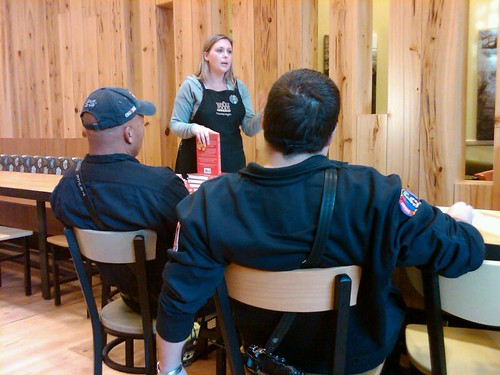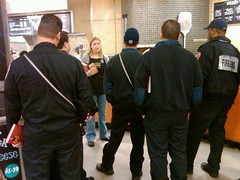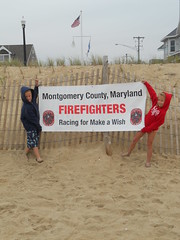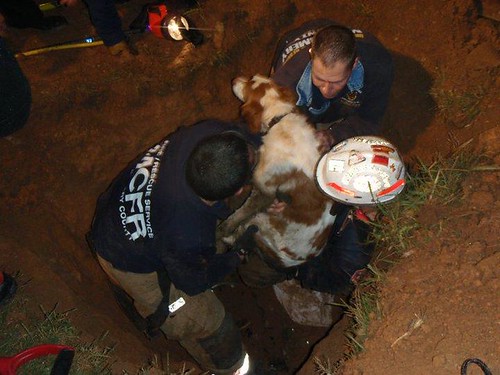 |
| Fire Chief Richard Bowers (at podium) joined volunteer and career firefighters, who spoke out in favor of Bill 13-10, Emergency Medical Services Transport Fee. Montgomery County voters will decide on November 2 whether to approve County Question A, which will allow the bill to become law. |
Many Montgomery County volunteers are stepping forward to join Career Firefighters and Paramedics in supporting the County’s Ambulance Reimbursement program. Some volunteer stations, including Silver Spring and Takoma Park, voted to remain neutral on the ballot question.
Why Ambulance Billing Makes Sense for Montgomery County
– A Volunteer Paramedic’s Perspective
by Erik S. Gaull
When residents of Montgomery County go to the polls on November 2nd, they will be presented with County Question A, a ballot initiative on whether to allow the County to recover costs from insurers for ambulance transport. There is a lot of misinformation floating around about so-called “ambulance fees.”
As a volunteer paramedic/firefighter in Montgomery County since 1986, I feel it is important that Montgomery County voters understand that many fire-rescue volunteers support the proposed emergency medical services (EMS) transport fee. But I don’t just speak as first responder. Since 1993, I have earned a living as a consultant to fire and EMS agencies across the nation, helping them to provide top-flight service to their communities during times of shrinking budgets. Moreover, I teach EMS management at the National Fire Academy. I have a considerable base of national experience from which to draw my observations about the transport fee.
Many of the volunteer fire departments in the County are staunchly against transport fees, a position I believe is short-sighted and based on some bad misconceptions. Such fees are more than just a good idea – they’re an essential means to preserve high-quality EMS in Montgomery County.
Simply put, without ambulance billing, Montgomery County is leaving millions of dollars in revenue in the corporate coffers of insurance companies. This is money that is urgently needed right now, as the County is facing unprecedented budget shortfalls and the real possibility of implementing fire-rescue service cut-backs. The County Council did the fiscally responsible thing in adopting ambulance billing, moving Montgomery County in line with almost every other jurisdiction in the National Capital Region. This action is long overdue.
Here are the chief arguments advanced by those against the fee and why those arguments are incorrect:
Assertion: Tax dollars already pay for EMS; therefore users of the system should not be expected to pay for the service.
Fact: Taxes support the overall operation and readiness of the EMS system (i.e., equipment, infrastructure, dispatching, training, etc.) but the County’s Fire Tax doesn’t cover all the costs at the present – and will cover fewer in the future. The transport fee will be paid by Medicare, Medicaid, and private insurance – not by County residents, and co-pays will not be required from County residents. In other words, the County will only be seeking payment from insurance companies – not individuals.
Assertion: Premiums will rise if insurance companies have to pay ambulance bills.
Fact: Insurance premiums anticipate the projected use of ambulance service by an insured party. In other words, County residents presently pay premiums which assume that the insurance company will need to pay for an ambulance transport. When someone uses a “free” (i.e., non-billing) ambulance service, the insurance company pockets the money it has already calculated it will need to lay out on behalf of its insured population. Insurance premiums won’t rise because the insurance companies are already expecting to pay out that money.
Assertion: Ambulance fees will deter people from calling EMS in an emergency.
Fact: There is no evidence to support the notion that people will be less likely to call for an ambulance because a jurisdiction imposes an ambulance fee. In fact, according to the billing records of Intermedix, the largest ambulance service billing company in the nation, jurisdictions which have recently implemented ambulance fees have not seen a decrease in the number of transports.
So, the arguments against an ambulance fee don’t really hold water, but the arguments for the fee are strong:
First, the County needs the money. The Montgomery County Fire and Rescue Service has already undergone some service cutbacks, and more are on the table in order to close budget gaps.
Second, the fee will be paid by users’ health insurance, and the County has carefully crafted mechanisms for non-County uninsured, low-income users to request a fee waiver. Insurers of non-residents will receive a bill, meaning Montgomery County taxpayers will not be subsidizing ambulance service for people who do not pay taxes in the County.
The bottom line is this: A vote FOR Question A is a vote to preserve and strengthen fire-rescue service levels. A vote against Question A is essentially a vote to CUT BACK fire-rescue service, while leaving County taxpayers to foot the bill and letting insurance companies keep premiums already paid.
The author is a Nationally Registered Paramedic and has been a volunteer paramedic/firefighter in Montgomery County since 1986. He has been a consultant to fire and EMS agencies across the United States since 1993, teaches EMS management at the National Fire Academy, and sits on the Editorial Review Board of two EMS-related publications.
* * *
Ambulance Reimbursement from a Volunteer Paramedic’s perspective
By Pamela Boe
I am Pamela Boe, and I am a paramedic associated with the Upper Montgomery County Volunteer Fire Department, who wishes to clarify some misinformation being spread about Question A, the Ambulance Reimbursement ballot measure.
The Montgomery County Volunteer Fire and Rescue Association (MCVFRA) did, in fact, vote to fight the implementation of the law that allows the County to seek reimbursement from insurance companies, Medicare and Medicaid for ambulance transports, but that decision by the MCVFRA won only by a slight margin.
As it is, many of the volunteers I work with do not agree with the Association’s stance against ambulance billing, yet we have no voice within that Association as individuals. We have watched helplessly as the Volunteer Association has manufactured facts, misquoted figures, manipulated words and spread fear among the general populace about future fees, hard billing, or where the money is going.
A primary reason the Volunteer Association does not wish to see this pass is because they fear it would result in fewer donations to the individual Volunteer Fire Departments by the community. They fear the community would think, “Why would I donate when the insurance company is already paying?” The answer is that the insurance company won’t pay for all of it. Furthermore, dear taxpayer, you are already paying for it in both your insurance AND your taxes. How does that make sense?
If this law gets repealed, and the ambulance reimbursement requests do not go to insurance companies, there are going to be fewer ambulances and medic units available. The loss of $14 million dollars in an already VERY tight budget will result in the loss of career firefighters and therefore the loss of emergency services.
The volunteers will not be able to pick up the slack. In other words, folks, we NEED that money.
I am not a registered Republican, but I DO believe in smaller government, and I would rather see any money that is reimbursed by the insurance companies returned to the tax payers. It is a shame that the vote didn’t go that direction when the issue of reimbursement originally came up. But, the law was passed, and the resulting income was counted on in this year’s budget. The horses are already out of the barn. Returning them would cost the county $14 million. That means it would cost YOU AND ME $14 Million, either in the form of money or services. It has got to come from somewhere…its either going to come from a tax hike, new County-imposed fees elsewhere, or cuts in services.
Understand this: If you vote “no” on the Ambulance reimbursement, it will translate to you, the county taxpayer, as longer response times during an emergency because there will be fewer units and fewer personnel out there to respond -- OR it will translate to you in the form of higher taxes and fees -- OR BOTH. Every Department in the county could be at risk in this cut.
I am voting YES on Question A to keep the law that allows reimbursement for County ambulance services, and I am a County Volunteer Medic, and I see first-hand why this county needs it.
 MCFRS hopes all of you have a SAFE New Year’s eve tonight! I found this great article on WTOP.com with information on how you can get a free ride if you have had a bit too much to drink. Drunk driving is a preventable incident – it is NOT accident when one occurs!
MCFRS hopes all of you have a SAFE New Year’s eve tonight! I found this great article on WTOP.com with information on how you can get a free ride if you have had a bit too much to drink. Drunk driving is a preventable incident – it is NOT accident when one occurs!
























